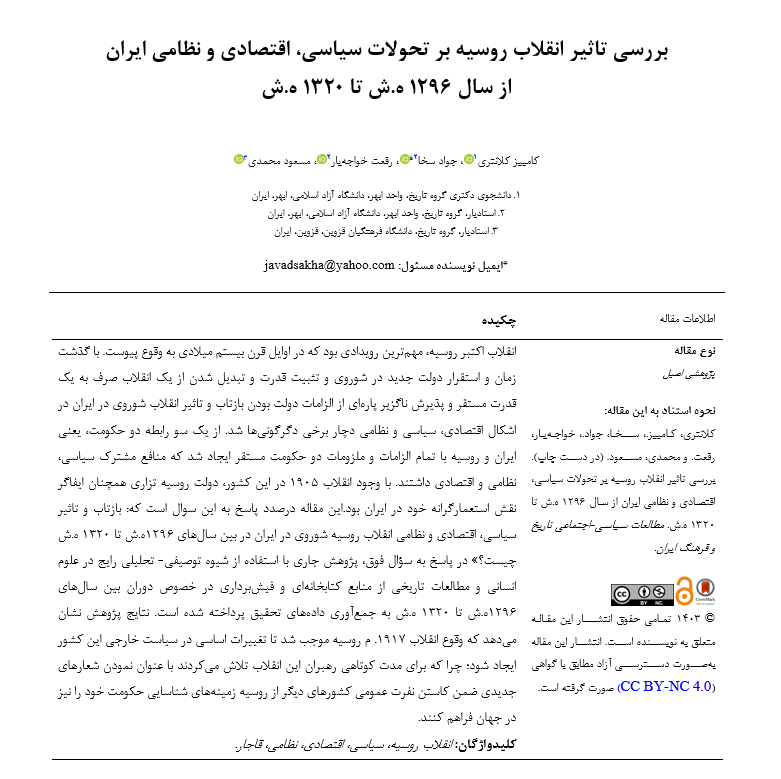The Effectiveness of the Russian Revolution on Iran’s Developments During the Reza Shah Era
Keywords:
Russian Revolution, Political, Economic, Military, QajarAbstract
The October Revolution of Russia was the most significant event that occurred in the early 20th century. Over time, with the establishment of the new Soviet government, consolidation of power, and its transformation from a mere revolution into an established power, the Russian Revolution's reflection and impact on Iran underwent changes in the economic, political, and military spheres. On the one hand, a relationship between the two governments, namely Iran and Russia, was formed, with all the obligations and necessities of two established governments that had shared political, military, and economic interests. Despite the 1905 revolution in Russia, the Tsarist Russian government continued to play its colonial role in Iran. This article seeks to answer the question: "What were the political, economic, and military impacts and reflections of the Russian Revolution in Iran from 1917 to 1941?" In response to this question, the present study employs a descriptive-analytical method, common in the humanities and historical studies, to gather data from library sources and note-taking regarding the period between 1917 and 1941. The results of the research indicate that the 1917 Russian Revolution led to fundamental changes in the country's foreign policy. For a brief period, the leaders of this revolution sought to promote new slogans in an attempt to reduce the public animosity towards Russia in other countries and to create the conditions for international recognition of their government.
Downloads
References
Afary, J. (2000). The Constitutional Revolution of Iran. Biston.
Ansari, A. (1968). The First Soviet Political Representative in Iran. Dunya Yearbook.
Bahar, M. a.-S. M.-T. (1978). A Brief History of Political Parties. Amir Kabir.
Bastani Parizi, M. I. (1978). The Epic of the Desert. Amir Kabir.
Behnam, J. (2004). Iranians and Modernity Thought. Forouzan Rooz.
Brinton, C. (1987). Anatomy of Four Revolutions. No Publishing.
Carmichael, J. (1984). History of the Russian Revolution. Razi Publishing.
Carr, A. H. (1992). History of Soviet Russia: The Bolshevik Revolution 1917-1923. Rosaneh Publishing.
Fourn, J. (2001). Fragile Resistance (History of Social Changes in Iran). Rasa Publishing.
Gromyko, A. (1990). Memoirs of Andrei Gromyko. Etela'at Publishing.
Hedayat. (1984). Report on Iran. Naghre Publishing.
Kerensky, A. (2003). Memoirs of Kerensky, Leader of Russia's Provisional Government Before the Communist Victory. Forouzan Rooz.
Lamptoon, A. C. (1996). Iran in the Qajar Era. Javedan Khord.
Lavasani, S. (1984). The Movement of Mirza Kuchak Khan and the First Soviet Republic in Iran. Chapkhshi.
Lechart, C. (1967). Memoirs of an English Agent. Firouz Publishing.
Lenin, B. (1982). Iran and the Eastern Nations. Doran Publishing.
Lenzowski, G. (1974). Russia and the West in Iran. Javidan Publishing.
Malek Arā, A. M. (1946). Biography. No Publisher.
Manshour Gorgani, M. A. (1989). Soviet and British Rivalry in Iran from 1896 to 1926. Attai Institute.
Meredith, C. (1971). Early Qajar administration: an analysis of its development and functions. Iranian Studies, 4(2-3), 59-84. https://doi.org/10.1080/00210867108701411
Mir Ahmadi, M. (1987). Research in Contemporary Iranian History. Astan Quds.
Morin, M. (1960). History of the Major Powers from 1919 to 1947. Ali Akbar Scientific.
Mostofi, A. (1945). The Life of My Life or the Social and Administrative History of the Qajar Period. Scientific Publishing.
Navazani, B. (1990). The Iran-Soviet Friendship Treaty. Hamrah Publishing.
Nikitin, M. (1984). Memoirs and Travelogue. Kanon Ma'refat.
Palmer, R. (1969). A History of the Modern World. Amir Kabir.
Pavlovich, M., & Iranski, T. S. (1950). The Constitutional Revolution of Iran. Amir Kabir.
Polak, J. E. (1989). Polak's Travelogue: Iran and Iranians. Khwarazmi.
Rahbari, H. (2008). Merchants and the State in the Qajar Era (From Coexistence to Confrontation). Kavir.
Razaghi, I. (1997). Introduction to the Economy of Iran. Ney Publishing.
Sepehr, A.-A. M. a.-D. (1983). Iran in the Great War. Adib.
Sheikh al-Islami, J. (1989a). Confidential Documents of the British Foreign Office Regarding the 1919 Iran-Britain Agreement. Kayhan Publishing.
Sheikh al-Islami, J. (1989b). The Image of Ahmad Shah Qajar. Goftaar.
Sheikholeslami, A. R. (1997). The structure of central authority in Qajar Iran, 1871-1896.
Teymouri, I. (1953). The Age of Ignorance or the History of Concessions in Iran. Nasabi Haj Mohammad Hossein Iqbal and Co.

Downloads
Published
Submitted
Revised
Accepted
Issue
Section
License
Copyright (c) 2024 kambiz kalantari (Author); Javad Sakha (Corresponding Author); Rafat Khajeh yar , Masoud Mohammadi (Author)

This work is licensed under a Creative Commons Attribution-NonCommercial 4.0 International License.







